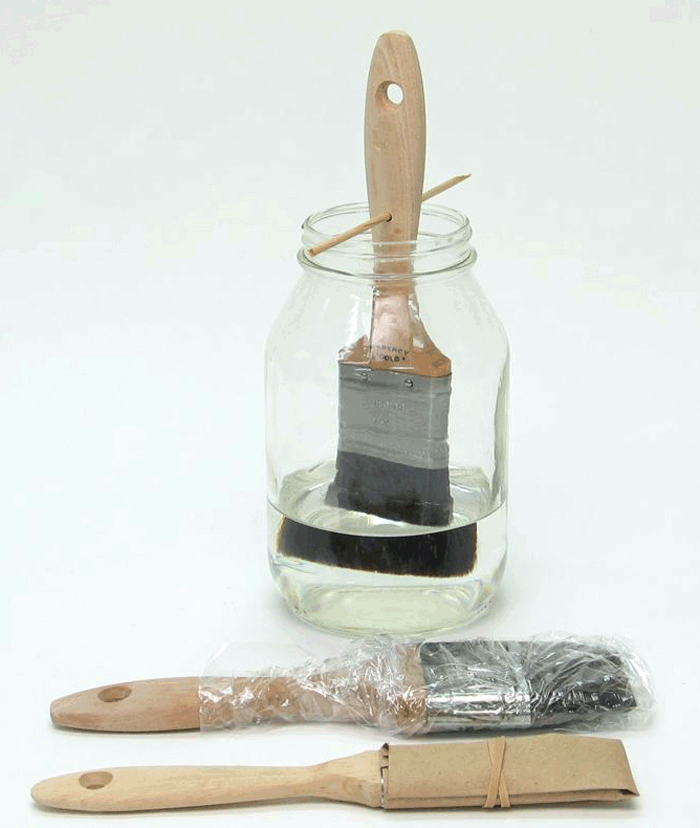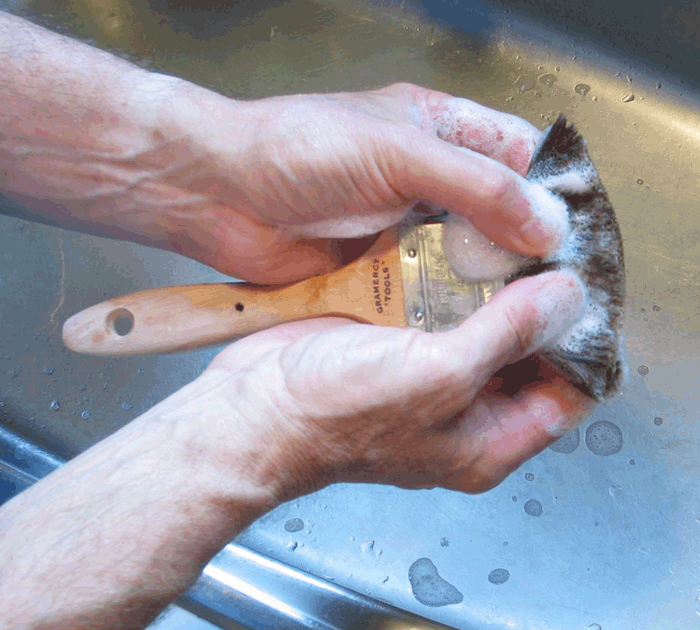The Art of Brushmaking
and
The Gramercy Tools Finishing Brush
 Please click for more information and to purchase our Gramercy Tools Finishing Brushes
Please click for more information and to purchase our Gramercy Tools Finishing Brushes

How to Clean a Finishing Brush
Introduction
Cleaning a brush is different for each type of finish.
 When you are done finishing your work, you must clean your brush. If you
are just done for that session and plan to use your brush within a day or so,
you can delay a complete cleaning and keep the bristles from hardening for a day or
two by wrapping the brush in plastic wrap to prevent air contact. Another method of keeping
the brush from drying out is to hang the brush in the solvent used for
the finish. You may need to drill a new hole in the handle if the jar
or other container you use isn't deep enough. Don't let the bristles touch
the bottom of the container or they may become permanently bent. There
is a risk here of course that the plastic wrap isn't tight enough or that
the finish evaporates before you return to finishing, but with normal precautions
storing a brush wet is a good way to minimize the amount of cleaning you
actually have to do. Some finishes like shellac, however, are so easy to
redissolve that a dried brush isn't a problem.
When you are done finishing your work, you must clean your brush. If you
are just done for that session and plan to use your brush within a day or so,
you can delay a complete cleaning and keep the bristles from hardening for a day or
two by wrapping the brush in plastic wrap to prevent air contact. Another method of keeping
the brush from drying out is to hang the brush in the solvent used for
the finish. You may need to drill a new hole in the handle if the jar
or other container you use isn't deep enough. Don't let the bristles touch
the bottom of the container or they may become permanently bent. There
is a risk here of course that the plastic wrap isn't tight enough or that
the finish evaporates before you return to finishing, but with normal precautions
storing a brush wet is a good way to minimize the amount of cleaning you
actually have to do. Some finishes like shellac, however, are so easy to
redissolve that a dried brush isn't a problem.
Shellac
You don't have to clean a shellac brush if you use it only for shellac
because dried shellac dissolves so quickly in alcohol. Simply wrap the brush
to keep it clean, then soak it in denatured alcohol for several minutes
before using the next time.
To clean the brush, rinse it several times in clean denatured alcohol, shaking
out as much of the liquid as possible between each rinse. Or, much easier
and more effective, rinse it in household ammonia and water, about one part
ammonia to two parts water. Then wash in soap and water as described below.
Lacquer
You don't have to clean a lacquer brush if you use it only for lacquer
because dried lacquer dissolves so quickly in lacquer thinner. Simply wrap
the brush to keep it clean, then soak it in lacquer thinner for several
minutes before using the next time.
To clean the brush, rinse it several times in clean lacquer thinner, shaking
out as much of the liquid as possible between each rinse. Then wash in soap
and water as described above.
Water-Based Finish
Wash in soap and water as described above. It is important to remember that once a water based polymerizing finish dries in the brush, it is no longer water soluble, so remember to clean the brush promptly after use.
Oil and Varnish
Rinse several times in clean mineral spirits (paint thinner), shaking
out as much of the liquid as possible between each rinse. Then rinse in
lacquer thinner and shake. This removes the oily mineral spirits and makes
washing with soap and water easier. Then wash in soap and water as described
above.
Oil and varnish finishes are the most difficult to clean from brushes. Be
sure you have completely washed the oily feel from the bristles before storing
the brush. The bristles should not be stiff after they have dried from the
washing.
Final Steps
 The step for cleaning a brush is the same for all types of finish.
Wash the brush in soap and water until the
soap sudses to its maximum, and wrap the brush in paper to keep it clean
and cause the bristles to dry straight. Construction paper (like the kind of paper your
brush came packed in) is best because
it absorbs water best, but any type of paper will work. Hold the wrapping
in place with masking tape or a rubber band.
The step for cleaning a brush is the same for all types of finish.
Wash the brush in soap and water until the
soap sudses to its maximum, and wrap the brush in paper to keep it clean
and cause the bristles to dry straight. Construction paper (like the kind of paper your
brush came packed in) is best because
it absorbs water best, but any type of paper will work. Hold the wrapping
in place with masking tape or a rubber band.
Our Gramercy brushes have very fine ox-hair bristles, which can become bent and intertwined during washing, so it's best to comb them straight before wrapping. A hair comb works well.
|
Hours: M-F 9:00-5:00, closed Sat,Sun Our Guarantee & Return Policy Shipping and Sales Tax Info Privacy Policy Holiday Calendar |
|
Contact Us:
Email: support@toolsforworkingwood.com Phone: 800-426-4613 or 718-499-5877 Visit Us in Brooklyn: Directions to Our Showroom © 1999-2019 toolsforworkingwood.com Powered by 01 Inc. Coded entirely in NYC |


